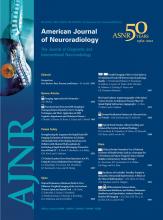Article Figures & Data
Tables
- Table 1:
PVO for anterior circulation aneurysms: demographics, follow-up, and complications
Case No. Age (yr)/Sex Location Size (mm) Presentation FU (days) Aneurysm Obliterated Complications/Comments 1 85/F Cavernous 32 H/A, visual loss n/a No Balloons deflated, infarction without clinical deficit, treatment abandoned 2 56/F Cavernous 17 Visual loss 65 Yes None 3 62/F Cavernous 29 H/A, CN palsy 115 Yes Transient Horner syndrome 4 62/F Cavernous 23 H/A, CN palsy 236 Yes Partial deflation of proximal balloon, no clinical sequelae 5 58/F Cavernous 27 H/A, CN palsy n/a No Partial deflation of proximal balloon, cortical infarction with minor clinical deficit, early aneurysm growth provoked surgical trapping with STA-MCA bypass 6 68/F Cavernous 35 H/A, CN palsy 867 Yes None 7 39/M Cavernous 30 H/A, CN palsy 4914 Yes Growth of posterior circulation aneurysm 8 52/F Cavernous 30 H/A, CN palsy, visual loss 6539 Yes Growth of contralateral (mirror) cavernous aneurysm 9 60/F Parophthalmic 14 Incidental 181 Yes None 10 62/F Parophthalmic 25 Visual loss 416 Yes None 11 64/F Parophthalmic 39 Cognitive decline, hydrocephalus 420 Yes None 12 74/F Parophthalmic 16 Visual loss 484 Yes None -
Note:—CN indicates cranial nerve; H/A, headache; STA-MCA = superficial temporal artery-middle cerebral artery.
-
- Table 2:
PVO for posterior circulation aneurysms: demographics, follow-up, and complications
Case No. Age (yr)/Sex Location Size (mm) Presentation FU (days) Aneurysm Obliterated Complications/Comments 13 44/F VB 7 SAH 63 Yes None 14 52/F VB 13 SAH 185 Yes None 15 63/M VB 5 SAH 656 Yes None 16 60/F VB 6 SAH 729 Yes None 17 50/F VB 8 SAH n/a No Persistent filling of aneurysm after proximal VA occlusion, large PICA incorporated into dissecting pseudoaneurysm, underwent surgical trapping and PICA-PICA bypass 18 51/F VB 5 SAH 1379 Yes None 19 64/F VB 25 Brain stem compression, H/A 515 Yes None 20 55/F VB 26 CN palsy 794 Yes Lateral medullary infarction with clinical deficit 21 44/M VB 34 Brain stem compression 1839 Yes None 22 19/M VB 20 Brain stem compression 2123 Yes Brain stem infarction with clinical deficit 23 58/F VB 26 Brain stem compression 3360 No Transient episode of “tunnel vision” 24 67/F VB 20 Brain stem compression, cognitive decline n/a No Vessel rupture, death 25 74/M VB 28 Brain stem infarction n/a No Brain stem and cerebellar infarctions, death 26 54/M PCA 20 Incidental 213 Yes None 27 30/M PCA 29 Incidental 770 Yes Transient hemisensory and motor deficits 28 32/F PCA 26 Incidental 2439 No Transient homonymous hemianopsia -
Note:—CN indicates cranial nerve; H/A, headache.
-
- Table 3:
PVO for complex intracranial aneurysms: summary of obliteration rates, morbidity, and mortality
Obliteration Rate (%) Mortality (%) Permanent Major Deficit (%) Permanent Minor Deficit (%) Anterior circulation aneurysms 83.3 0.0 0.0 8.3 Posterior circulation aneurysms presenting with SAH 83.6 0.0 0.0 0.0 Posterior circulation aneurysms presenting with mass effect 57.1 28.6 28.6 0.0 PCA aneurysms discovered incidentally 67.7 0.0 0.0 0.0












